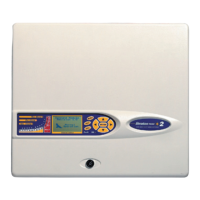Page 21
Stratos HSSD-2 • INSTALLER’S HANDBOOK • Iss. 12
3.4.34 Factory default (Yes/No - Address 000 - 127)
Setup menu > Miscellaneous
On the Standard Detector, this function has two purposes. If the user has changed any
of the detector’s functions, this function will display No , indicating that the detector
is not at factory default. Setting the function to Yes will restore the detector to the
factory default settings.
On the Command Module, this setting returns all detectors on the communications
loop to their default settings. To default an individual detector in the loop, it is
necessary to use the detector’s own front panel.
3.4.35 Scan devices (Yes/No - CM only)
Setup menu > Bus setup
Setting this function to Yes causes the Command Module to scan the RS485 data bus
for connected detectors. While scanning, the display will show Scanning loop and
display a progress bar. When finished, the display will show the number of devices
found and the detector addresses in the form.
The list “wraps around”, so that pressing <up arrow> when viewing Address 001
brings up detector number 127. Pressing <right arrow> allows the user to remove a
detector address from the loop (by changing ‘Y’ to ‘N’), or to re-instate a previously
removed detector (by changing ‘N’ to ‘Y’). This is different from the Isolate function in
that a fault is still generated on the Command Module. However, this may need to be
done if replacing a detector on the loop so that the detector’s address becomes available
to the replacement. After replacing the detector, the address may be re-enabled.
3.4.36 Looped bus (Yes/No - CM only)
Setup menu > Bus setup
This function is set to Yes to signify that the detectors are connected to the Command
Module in a fault tolerant loop configuration (see section 8.2.1 for details). Failing
to set this value to Yes for a loop configuration will mean that the fault monitoring
advantages of the detector loop are lost. Setting the value to Yes for a non-fault
tolerant configuration will generate detector loop errors, so it is important that the
appropriate configuration is identified.
3.4.37 Poll timeout (Numeric - CM only)
Setup menu > Bus setup
This is the time, specified in milliseconds, which a device has to respond to a poll from
the command module. If no response is received for this time then a Comms fault
message is shown for this device on the Command Module display. This may be caused
by communications delays, e.g. when units are communicating across a Wide Area
Network. This function may then be set to a more suitable value.
NB: If in doubt about the setting of this function, please contact the Kidde Products
Ltd. help line (see page 3).
001 loop 1 Y
002 loop 1 Y
003 loop 1 N
Press
to change

